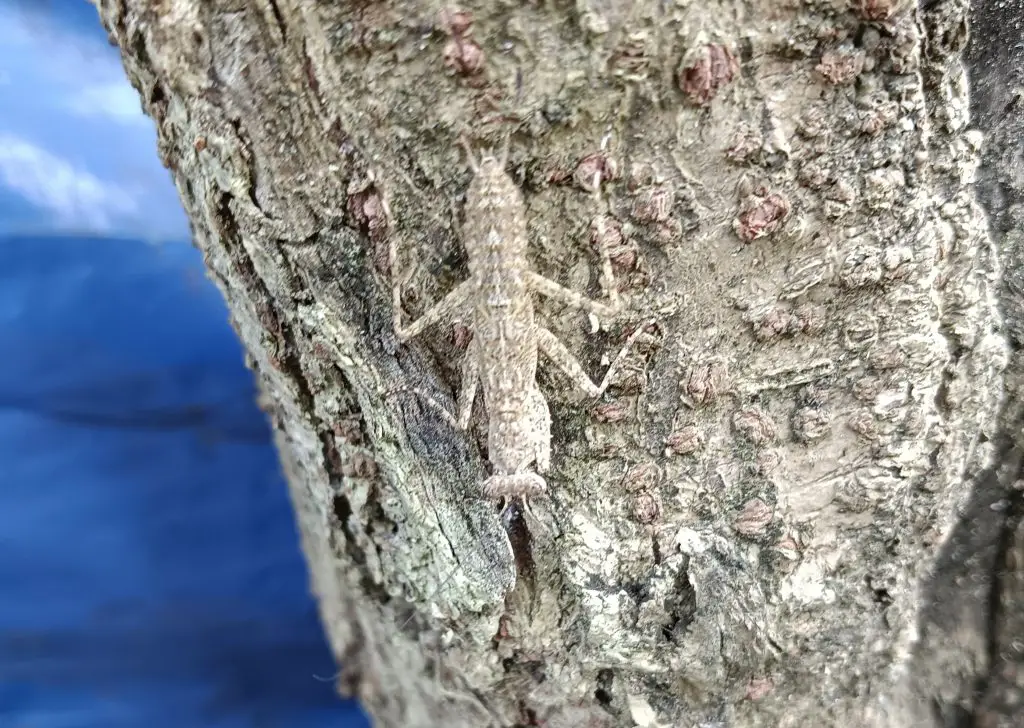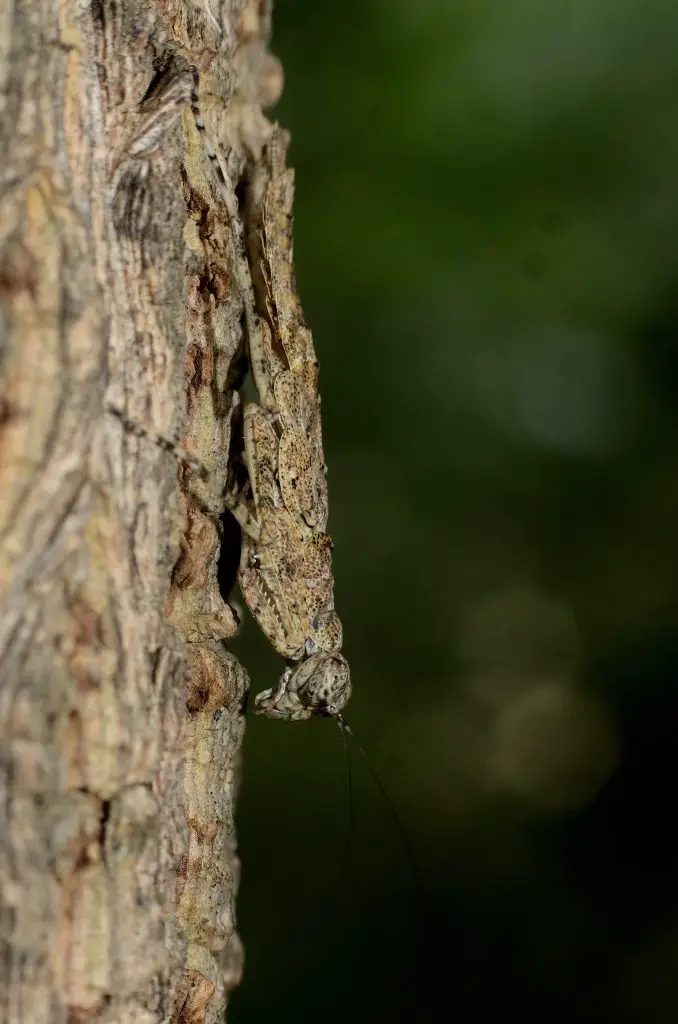Humbertiella is an intriguing and captivating genus of praying mantises, known for their remarkable bark-imitating abilities. These small to middle-sized mantids boast incredible speed, making them quite the agile predators in their natural habitat.

General Description
This unique genus of mantids boasts at least 10 distinct species, each with its own fascinating characteristics. Among the known species are Humbertiella ceylonica, discovered by SAUSSURE in 1869, H. indica, also identified by SAUSSURE in 1869, and H. similis, brilliantly described by GIGLIO-TOS in 1917.
One striking feature of Humbertiella is their incredible speed. They are nimble and swift, making them perfect hunters in their natural environment. These mantids are skilled at hunting and living amidst the bark of trees, their camouflage enabling them to blend seamlessly with their surroundings.
As nymphs, Humbertiella mantises display a typical appearance, especially from their L2 stage onwards. Resembling larger nymphs, they retain their remarkable agility and voracious appetites even at this early stage of development.
Known by its Latin name, Humbertiella spec., this mantis species falls under the Super-Order Dictyoptera, the Order Mantodea, and the Family Liturgusidae. Within this family, they belong to the Subfamily Liturgusinae and the Tribe Liturgusini.
Humbertiella mantids predominantly inhabit the bark and branches of trees, favoring damp areas as their chosen dwellings. Their preference for such environments further highlights their unique adaptation to their ecosystem.
When it comes to aggressiveness, these mantises are not ones to be taken lightly. They exhibit a very high level of aggression towards their prey and even towards other mantises, making them formidable hunters in their niche.
Humbertiella: Male vs Female
Size
The males and females of the Humbertiella species showcase intriguing differences that contribute to their unique characteristics. Males of this species typically measure around 3.5 centimeters, while females tend to be slightly larger, with an approximate size of 4.5 centimeters. The disparity in size is just one aspect that sets them apart.
Lifespan
In terms of lifespan, both genders exhibit relatively similar durations, adding to their remarkable nature. Male Humbertiella mantises have an approximate lifespan of around 8 months, inclusive of their nymph stage of 5 months and adulthood of 3 months. On the other hand, female mantises tend to have a slightly extended lifespan of about 8.5 months, encompassing a nymph stage of 5.5 months and an adult stage of 3 months.
Sexing
Sexing these mantises holds its own unique challenges. In the case of males, differentiation is achievable once they reach the L5 stage and beyond. At this point, the abdominal segments at the base of the abdomen, totaling 8 segments, serve as a distinguishing feature. Upon reaching adulthood, male Humbertiella mantises exhibit a more slender body compared to their female counterparts.
Similarly, for females, the identification process advances from the L5 stage onwards, where the abdominal segments at the base of the abdomen are counted. In the case of females, this count typically comprises 6 segments. When they mature into adults, female Humbertiella mantises are characterized by their larger abdomen, setting them apart from the males.
The nuanced differences between male and female Humbertiella mantises enhance the fascination surrounding this species. From size discrepancies to abdominal segment counts and distinct body shapes, these distinctions add to the allure of observing and studying these mantises. As you delve into the world of Humbertiella, take note of these features that contribute to their captivating diversity.

Keeping
Lighting, Humidity and Temperature
Providing the perfect environment for Humbertiella mantises is paramount to their well-being and development. These remarkable creatures thrive under specific conditions that mimic their natural habitat. While natural daylight is sufficient, it’s recommended to supplement with Halogeneous lamps or other suitable lighting sources to enhance their living space. A light cycle of approximately 12 hours is ideal to regulate their day-night rhythm.
Maintaining a consistent temperature range during the day is crucial, with temperatures between 25°C and 35°C ensuring their comfort. Nights should remain relatively warm, not dropping below 20°C to safeguard their health. Humidity plays a vital role in their habitat, with daytime levels ranging from 60% to 90%, and nights maintaining a high humidity of 80% to 100%. Spraying the enclosure every evening helps maintain the desired humidity levels, creating an environment conducive to their well-being.
Enclosure
For their living space, single keeping is recommended, with minimal terrarium dimensions of at least 15cm x 15cm x 20cm. Creating a natural environment within the terrarium is beneficial, incorporating branches, plants, twigs, leaves, bark sticks, and trunks (around 10cm in diameter, such as beech or lilac) for them to explore and perch on. The terrarium substrate should consist of an earth-sand mixture and pulp, providing a suitable substrate for keeping humidity level.
A crucial tip for creating their habitat is to ensure ample hanging space for safe molting. Having a structure at the top of the enclosure that mantises can hang from is essential. Window screen mesh serves this purpose remarkably well, providing a secure space for molting while preventing potential mishaps.
Preferred Food
When it comes to their diet, Humbertiella mantises thrive on a varied menu. Drosophila, flies, moths, cockroaches, and small crickets make for ideal food choices, ensuring they receive the necessary nutrition for growth and vitality. While there are no specific species needing similar care, adhering to these guidelines guarantees a thriving environment for your mantises.
Breeding
Breeding Humbertiella mantises unveils a series of carefully orchestrated steps that highlight their unique reproductive journey. Males and females exhibit distinct timelines when it comes to copulation-readiness. Approximately one week after the last molt, males are prepared for copulation, while females require about two weeks post-molt before reaching their readiness.
When it comes to the ooth placement, pregnant Humbertiella mantises prefer to position their egg cases at the bark near the ground or directly on the ground. These ooths typically measure around 2.5 centimeters in size, boasting a box-shaped, elongated structure. The coloration leans towards yellow or light brown, contributing to their distinctive appearance.
Creating the optimal conditions for breeding Humbertiella mantises involves maintaining a temperature range between 25°C and 32°C. Humidity levels play a pivotal role, ranging from 70% to 90%, striking a balance between adequate moisture and preventing excess wetness. Adequate ventilation is a key consideration during breeding, ensuring a conducive environment for the mantises.
Offering a pro tip, providing the female with some food is beneficial during mating. This approach keeps her engaged with prey while the male approaches, potentially easing the mating process.

Conclusion
Whether you’re drawn to their remarkable appearance, behavior, or the challenge of providing a nurturing environment, Humbertiella mantises offer a captivating experience. Their ability to bridge the gap between the natural world and our understanding of it underscores the intricate beauty that lies within the realm of these unique creatures. As you embark on your journey with Humbertiella mantises, remember that each piece of information gleaned contributes to a richer appreciation of these exceptional insects.